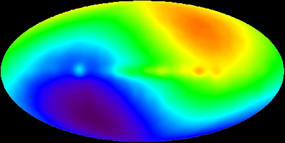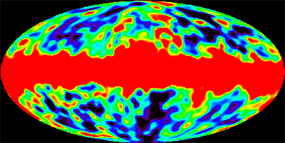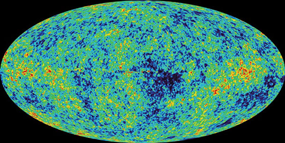Imaging the CMB

Our first view of the CMB
In order for scientists to take detailed pictures of the CMB, they first had to figure out how to remove several obstacles that stood in their way. Because the background radiation is almost completely isotropic, at first glance it looks to be pretty much the same temperature no matter where you look. These images, gathered by WMAP, show hotter, less dense regions as red and cooler, denser regions as blue. As you can see from the initial, monochromatic view of the sky, the CMB has a pretty uniform temperature of 2.73 Kelvin. Only when we look for irregularities of one part in 1,000 K do we see any fluctuations.

A closer look at the CMB, showing the dipole
The Dipole
Once we look for more subtle variations in temperature, two distinct poles appear: a warmer one at the top right and a cooler one at the bottom left. Because of our solar system's motion against the background of the universe, microwaves are blueshifted in one direction and redshifted in the other. Just as more rain hits the front of a car driving in the rain, the direction in which we are moving appears warmer. Of course, this is a very small discrepancy (just +/- .003 K), and it means that our sun is moving at 368 km/s relative to the rest of the universe.

Our hot Milky Way
The Milky Way
After we account for the dipole and look 100 times closer, we start to see what the CMB really looks like. However, there is one last obstacle across the sky. That red band in the way is the Milky Way galaxy. Because we're inside it, our galaxy is close enough to contribute its own microwave radiation, and it contributes slightly more warmer microwaves than cooler waves. We are now looking at anisotropies on the order of 10 μK, one part in a hundred thousand Kelvin. Already we can see the dark, dense regions of space that existed almost 14 billion years ago.

The Final View of the CMB
The Full View
Finally, now that we've accounted for the dipole and the Milky Way, we can see the hidden features of the Cosmic Mircowave Background. These tiny fluctuations in temperature, some of them mere millionths of a Kelvin, are the seeds in the ancient universe that would become galaxies and clusters of galaxies in the present. These features are relics of the Big Bang, just like the radiation itself.